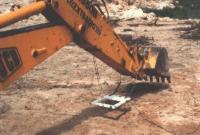Main menu
You are here
Safe Excavation - New Technology
Safe Excavation

The Need
Excavation cave-ins cause about 75 deaths and 1,000 injuries a year in the US, including about 140 that result in permanent disability.
Excavating with a backhoe or similar equipment has the potential risk of hitting an underground utility which could cause serious injuries and expensive damages. Contractors usually rely on utility companies or other professional services to mark the area where cables or pipes are buried. But without being able to know the depth and exact position of the line.
The Occupational Safety and Health Administration - OSHA - estimated that the fatality rate was at 50.8 deaths per 100,000 workers per year from 1984 to 1988. The National Institute of Occupational Safety and Health estimated that at least 127 persons were killed as a result of all excavation-related accidents (Huang et al. 1996).
The Technology
An electronic device that provides a real-time warning of the utility lines immediately ahead of the digging tool and provides an easily interpreted, real-time computer readout of the depth, location, and size buried metallic objects. Developed by Dr. Leonhard E. Bernold, it consists of an active metal detector search coil; a signal processing (control) unit; and a PC computer equipped with an analog-to-digital converter interface.
The active metal detector generates a magnetic field. Its impact on any metal object in its detection range is picked up by the control unit. The data is converted from analog to digital at a high sampling rate and transmitted to the computer. The computer receives real-time data about magnetic changes in the detector vicinity, graphs it on the screen, sounds a signal, and stores it in a file for future analysis.
The Benefits
The device helps in the detection and location of hidden underground cables, gas pipes, toxic waste drums and even bombs. It is a portable system that can be attached to backhoes, trenchers and other digging equipment.
Status
The system is ready for implementation but the designer is looking for investors and a production contract. An actual job site application of the system has not yet occurred. An enhanced device is being developed that can detect plastic-coated utility cables and fiber-optic telephone lines.
Barriers
The cost of the system is the current major barrier because of the lack of a production contract. The device will not detect plastic pipes or objects that do not have a metallic component. The detection depth or range of the system is limited by the capacity of the active metal detector.
Important Notes To Insure Safe Excavation
The Occupational Safety General Regulations are detailed and precise when dealing with excavations and trenches. Where a person may enter an excavation or trench and a wall of an excavation or trench is greater than 1.2 m in height, an employer shall ensure that the wall is supported by adequate shoring or bracing, or that an adequate trench cage is used, except where the employer is able to establish that the excavation or trench
(a) is cut in sound and stable rock;
(b) is sloped
(i) to within 1.2 m of the bottom of the excavation or trench, or
(ii) where soil overburden is located above an excavation or trench excavated in sound and stable rock, for the entire overburden,
and the slope does not exceed 1 m of vertical rise to each 1 m of horizontal run; or
(c) is one that a person does not enter within a horizontal distance from the walls of the excavation or trench that is equal to the height of the walls."
Source :

